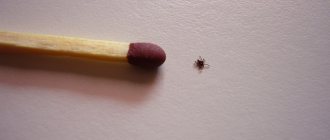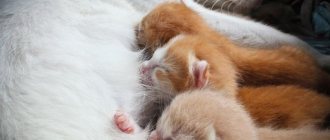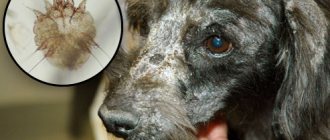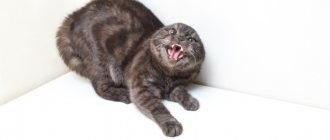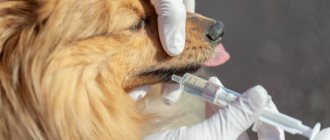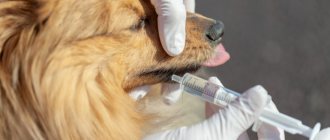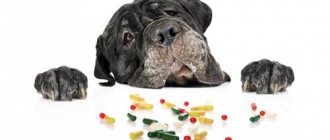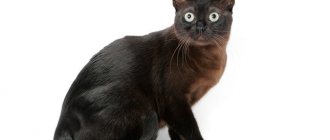Diseases of inflammatory etiology are among those that occur in pets not so rarely. One of them is eosinophilic granuloma in cats. It is accompanied by an inflammatory process on the pet’s skin and oral mucosa, which is most often caused by an allergic reaction to the bites of parasites such as fleas or mosquitoes, as well as hypersensitivity to certain components of the daily diet.
Eosinophilic granuloma complex is so named because of the immune cells that are classified in veterinary medicine as eosinophils (a type of white blood cell). According to experts, they are the initiators of the disease. The article will discuss the main causes and symptoms of the disease, as well as offer options for its effective treatment and prevention.
Description
Eosinophils are a subtype of leukocytes.
With the help of pseudopods, they move to the site of inflammation and absorb foreign cells, protecting the body. Eosinophils have cytotoxic properties, poisoning hostile cells. They bind and absorb a number of allergy and inflammatory mediators. Play a role in antiparasitic immunity. Granuloma in cats is a group of syndromes characterized by a persistent increase in the number of eosinophils. The mechanism is not fully understood, but it is known that such an increase causes a local reaction in the form of foci of inflammation on the skin. There are hundreds of times more eosinophils in the mucous membranes than in the blood, so granuloma in cats often affects the lips and oral cavity.
Although the disease is called eosinophilic granuloma complex (EGC), granulomas themselves do not always form in cats. In this regard, another name option was proposed - eosinophilic dermatosis. This is the same diagnosis, but the old name is used more often in the CIS countries.
It is believed that eosinophilic granuloma affects mainly young cats, but this is not entirely true. Simply, a hereditary predisposition to a malfunction of the immune system is detected at an early age. Cats get sick less often due to more stable hormonal levels.
This is a chronic condition that requires lifelong monitoring. Unfavorable factors provoke exacerbations and force a return to drug therapy. Cats and cats suffering from eosinophilic granuloma are removed from breeding.
Eosinophilic granuloma in cats
Content
Eosinophilic granuloma in cats is a lesion that occurs in animals in specific locations and has a different nature. The pathology becomes noticeable almost immediately and it is important to take timely and high-quality measures, since in most cases, this problem will arise again in the pet.
What is eosinophilic granuloma and why does it occur in cats?
Eosinophilic granuloma is a skin lesion in a cat that consists of ulcerated, visible reddish or whitish lumps. There is no gender or breed predisposition to the pathology. However, it is believed that the disease is hormone-dependent in nature and can manifest itself during puberty, withdrawal of corticosteroid treatment, etc. It first appears mainly in young animals (aged 2–5 years). Can be transmitted hereditarily through generations.
The exact cause of the development of the pathology has not been identified. However, the following factors contribute to the occurrence: hereditary factors, allergic reactions (food, atopic, parasitic nature), excessive sensitivity of the immune system.
Eosinophilic granuloma on the posterior thigh of a cat.
Nature of lesions
There is an eosinophilic granuloma complex in cats, which includes the following manifestations:
1. Indolent ulcer on the lips - it is believed that it occurs from licking (however, not all cats have this symptom):
- is a clearly defined defect with raised edges;
- occurs on one or two upper lips at once;
- no pain or itching,
- the surface of the ulcer is yellowish-brown, with whitish inclusions (as a rule, it does not bleed);
- the lip is swollen and enlarged.
2. Eosinophilic plaque - a lesion formed as a result of the fusion of many papules:
- a clearly defined inflamed area raised above the skin level;
- wet, shiny, eroded surface;
- localization - belly, groin area, internal and posterior surfaces of the limbs (those places where it is convenient for a cat to lick).
Eosinophilic granuloma on the hind legs of the Sphynx.
3. Eosinophilic granuloma - according to the location they are distinguished:
- oral granuloma (lesions are located in the mouth - upper palate, tongue);
- linear (on the back surfaces of the thighs, on the sides and abdomen) - compacted, tourniquet-like lesions (intradermal);
- on the chin (rounded) - swelling, practically does not itch, is not covered with hair;
- on the paws - a hard, itchy formation, noted in the interdigital area, on the heels or in the thickness of the paw pads.
The listed manifestations can occur complexly, or in a milder form, when lesions are noted in only one or two places.
The symptom of the disease appeared on the inner surface of the sphinx's ear.
Main symptoms
Each animal may have a different reaction; some symptoms may be more pronounced or weaker. The main visible signs of granuloma in cats are:
- itching - the cat bites its paws, fingers, intensively licks the abdomen and hind limbs;
- whitish bubbles appear on the tongue;
- visible lesions in the oral cavity (usually closer to the root of the tongue);
- decreased appetite;
- inflammation on the upper lip or chin (hairless, red, weeping areas of skin);
- elongated, dense lesions on the back of the thighs (less commonly on the forelimbs), usually without hair;
- visible inflammation on the inner surface of the ears;
- with a long course, secondary pyoderma occurs (when contaminated with pathogenic microorganisms).
How is the diagnosis carried out?
The following procedures are performed in the veterinary clinic:
- general examination of the pet and a detailed medical history (treatment for parasites, diet, living conditions, information about vaccination);
- material is taken from the affected areas (a smear or biopsy) and a cytological examination is performed;
- if necessary, carry out tank seeding;
- general clinical and biochemical blood tests - at the discretion of the veterinarian.
In differential diagnosis, exclude:
- squamous cell carcinoma (the lesions are somewhat different from granuloma and have a white color, more often occurs in older animals, additionally lesions are possible on the eyelids, in the area of the nostrils, ears);
- invasive diseases (skin parasites);
- infectious diseases (herpes, etc.);
- food allergies.
Treatment of granuloma in cats
When treating eosinophilic granuloma in cats, it is first necessary to identify and eliminate the underlying cause of the lesions. In veterinary dermatology, treatment for most skin problems begins with antiparasitic measures. If a food allergy is suspected, an elimination diet is prescribed for 6–8 weeks. It lies in the fact that new components are introduced into the cat’s diet that she has not eaten before (or has eaten for a long time and very rarely). If during this time the symptoms disappear, a “provocation” is carried out - they are returned to the previous diet. If all the symptoms of granuloma resume, it can be assumed that the root cause of the pathology was food allergy. If the symptoms do not go away when changing the diet, the atopic nature of the disease is suspected.
The following measures are used to treat skin lesions:
- glucocorticosteroids are prescribed in the form of injections or tablets (Prednisolone, Dexamethasone, Metipred, etc.);
- Chlorpheniramine is used to relieve itching;
- antibiotic therapy - for secondary contamination of affected areas of the skin - ointments and solutions are used topically (Kremgen, Akriderm, Miramistin, Iodinol);
- light therapy - the use of a Zepter Bioptron lamp. This measure is prescribed as additional therapy. The lamp improves microcirculation in tissues and accelerates the healing process of inflamed areas;
- If necessary, the pet is put on a protective collar for the entire course of treatment to prevent licking and scratching.
Prevention measures
Prevention of eosinophilic granuloma has not been developed. However, it is believed that limiting contact with substances that can cause allergic reactions (chemicals, cosmetics) can protect against relapse of the disease. It is necessary to carry out antiparasitic treatments in a timely manner and give anthelmintics. The cat's diet includes only high-quality products; the diet must be balanced. Cats with eosinophilic granuloma are removed from breeding.
Eosinophilic granuloma of cats is a pathology that is a consequence of a disruption in the functioning of the body. It occurs more often in adult animals, is inherited and is characterized by labor-intensive and lengthy treatment. Timely detection of the disease and elimination of symptoms helps improve the cat’s quality of life.
Causes
There is no consensus regarding the factors that provoke an increase in the number of eosinophils. The genetic nature of the granuloma has been confirmed; in cats, the tendency to overreact is inherited.
An increased immune response can be primary or secondary - a consequence of congenital pathology or acquired disease:
- atopic diseases (asthma, allergic dermatitis, rhinitis);
- fleas, ticks, lamblia, roundworms and other parasites;
- skin diseases (pemphigus, mycoses);
- sluggish and latent infections;
- long-term medication use;
- diseases of the gastrointestinal tract, joints;
- neoplasms;
- immunodeficiency.
The main cause of eosinophilic granuloma in cats is considered to be a malfunction of the immune system, although not all scientists share this opinion. Perhaps we are talking about some kind of dysfunction in the work of eosinophils themselves, which is genetically determined. The main factors that provoke exacerbation are stress, parasites and allergic reactions.
In most cases, it is not possible to find out what exactly causes the uncontrolled local accumulation of eosinophils, leading to chronic inflammation of the skin or mucous membranes. The primal nature makes complete recovery almost impossible. But symptomatic therapy makes it possible to achieve stable remission in this case as well.
How to support a weakened pet after illness
Cats undergoing treatment for granuloma and kittens that have recently recovered must be switched to special food. Foods that cause allergies must be removed from the diet. However, the team at the Murkosha shelter in any case recommends not feeding your pets food from the human table - this is not very useful, and often downright harmful.
Read more about proper cat nutrition: Proper cat nutrition
It is best to feed with dry or wet food of super premium or holistic class. And in case of granuloma, if recommended by a veterinarian, you need to buy dietary hypoallergenic cat food. But first you need to find out what component your pet is allergic to, and when purchasing, make sure that it is not in the composition. Because what works for one pet may make the problem worse for another. Places where the cat sleeps and eats must be cleaned every day, and water and food bowls must be disinfected.
Symptoms
Granulomas are foci of tissue proliferation, similar to dense nodules. In cats, these are whitish or yellowish “balls” on the surface of the affected area of skin. They are hard to the touch, up to 2 mm in diameter, sometimes visible only under a microscope. At the end of the cycle they are replaced by necrotic or connective tissue (sclerosis).
Affected areas are usually located on the lips, in the mouth, on the inner and back of the thighs, at the base of the tail and under it. But a receding hairline with chronic skin inflammation can appear anywhere.
Skin symptoms of eosinophilic granuloma in cats are present individually or in mixed form, with or without the formation of nodules:
| View | Description |
| Indolent ulcer | In the mouth or on the upper lip. The tissues are edematous, swollen, reddened. The ulcer is irregularly shaped, outlined, and does not bleed. The surface may be covered with a yellowish-gray coating. In most cases it does not itch and is painless. |
| Eosinophilic plaque | A clearly limited erosive lesion of an elongated shape. The skin seems to be torn off, red swollen areas glisten from constantly oozing lymph. Single plaques occur, but usually the lower abdomen and inner thighs are affected. Severe itching. |
| Miliary dermatitis | A red, crusty rash that is often mistaken for scratching. Localized on the back of the thighs, abdomen, armpits, and neck. It itches a lot and “burns.” |
In all cases, the hair on the affected areas of the skin falls out. The pet often licks itself and sometimes tries to gnaw out painful tissue. If you do not treat your cat, eosinophilic granuloma leads to enlarged lymph nodes, loss of appetite, exhaustion, and dehydration. Death is possible due to complications - pulmonary edema, renal or respiratory failure, pneumonia, secondary infections.
Symptoms of eosinophilic granuloma
The disease is characterized by a chronic course, so the symptoms increase gradually.
With inadequate treatment or its absence, the following symptoms develop:
- lymph nodes gradually hypertrophy, become painful, become denser, and merge with nearby ones into packets;
- purulent lymphadenitis develops, the temperature rises, appetite disappears, the animal is depressed;
- if the granuloma grows in the mouth, it becomes difficult for the cat to swallow, it starves and rapidly loses weight;
- Eosinophilic gastroenterocolitis develops, digestion is upset, blood is found in the feces, and vomiting often occurs;
- numerous skin rashes appear, which merge and cover a significant surface of the body, eczema occurs;
- When counting white blood cells, eosinophilia is detected.
Diagnostics
Eosinophilic granuloma in cats is described as similar to other diseases - bacterial and fungal infections, nodular and squamous cell carcinoma. Single local plaques resemble burns and bites. Therefore, a diagnosis is not made solely on the basis of examination and anamnesis.
Analysis of material taken with a needle from the thickness of the affected area shows a large number of eosinophils (more than 50%). In the superficial tissues of a chronic plaque or ulcer, the desired cells may not be present. It is important to ensure that the veterinarian takes the material correctly.
Comprehensive examination:
- histology is performed to exclude tumors in all cases of lip ulcers;
- herpesvirus is excluded if there are erosive plaques on the face;
- microscopic analysis of skin scrapings can identify parasites;
- general and biochemical blood tests to assess the general condition (exclude renal and liver failure, diabetes mellitus);
- in the presence of opportunistic flora in the affected areas, a culture is done for sensitivity.
In addition to the main diagnosis, it is advisable to find the cause of the disease. This can only be done by a competent dermatologist, allergist or immunologist through a comprehensive examination. General veterinarians rarely have sufficient knowledge, limiting themselves to symptomatic treatment according to a standard regimen.
Diagnostic features
To identify eosinophilic granuloma, differential diagnosis is required. The clinical picture of the disease cannot be called specific. To make an accurate diagnosis, it is important to exclude pathologies such as fungal infections, bacteria, and viral inflammation.
One of the main diagnostic methods is histology of a smear taken from the affected area of the mucous membrane. During the study, the doctor determines the presence of an inflammatory process and an increased concentration of substances - eosinophils in the sample. Eosinophils are epidermal cells that begin to be produced by the skin in the presence of an inflammatory process.
A mandatory stage of a diagnostic examination is to determine the cause of the pathological process. As a rule, allergy tests are performed to identify the triggering factor. The development of eosinophilic granuloma can be caused by household chemicals, as well as an insect bite, especially if the animal is hypersensitive.
Determining an allergen is a painstaking process, since anything can be an irritating factor. Allergy tests may take several days, so treatment of eosinophilic granuloma itself begins immediately after an accurate diagnosis is made in order to prevent the disease from spreading to neighboring, healthy areas of the skin.
Treatment
Unfortunately, local therapy does not produce tangible results. Systemic treatment of eosinophilic granuloma in cats involves partial suppression of leukocyte function. This selectively reduces local immunity, which allows for stable remission. Cases of complete recovery are rare.
First aid
The sick pet is given rest and immediately transferred to a mono-diet - turkey, rabbit, beef or white sea fish (all boiled). It must be a product that hasn't been on the menu for the last two weeks. If the cat eats ready-made food, it is changed to hypoallergenic or mirror-like in composition. For example, if the current food contains corn and chicken, the new food should contain rice and lamb.
If eosinophilic granuloma is suspected, the cat is treated for fleas. The best drug in this case is Stronghold (soft, suitable for pregnant women, fast acting, not dangerous when licked). A broad-spectrum deworming tablet (Dirofen, Kanikquantel +) is given internally, provided that the pet tolerates it well.
For extensive skin lesions, Suprastin is injected intramuscularly at a rate of 0.1 ml per 1 kg of body weight, choosing a healthy area for injection. The antihistamine will reduce tissue swelling, remove redness and itching, which will improve the pet’s condition. But these are symptoms - you still need to contact a veterinarian as soon as possible.
Basic treatment
To “lull the vigilance” of eosinophils, Prednisolone is prescribed. If there is no response, it is changed to Dexamethasone or Triamcinolone. These are strong steroid hormones, effective after 1-3 injections. Unfortunately, long-term therapy is required for remission, which is associated with a high risk of side effects.
An alternative is the immunosuppressant Cyclosporine. But it also has a lot of side effects, plus the risk of developing fatal toxoplasmosis. To suppress secondary infections, antibiotics are used topically or by injection. In some cases, surgical removal of the affected area of skin, cryo- or laser therapy is indicated.
If you suspect an allergic nature of the disease, it is important to identify and eliminate the allergen. The veterinarian will prescribe an elimination diet - foods are introduced into the diet one at a time, thus identifying the “provocateur”. It is advisable to donate blood for food allergens. Change bedding, toilet filler, floor cleaner, pet cosmetics and anything that potentially provokes the immune system.
Given that treatment for feline eosinophilic granuloma involves steroids, it is highly advisable to neuter your pet. Removing the uterus and ovaries (testes in cats) will avoid cancer of these organs, which is likely as a side effect of hormone therapy. In addition, sexual hunting is always stressful, causing an exacerbation.
Drugs for the treatment of dermatitis in cats caused by EEG
Treatment is aimed primarily at finding out the cause and bringing it under control. Symptomatically used drugs to reduce itching are steroids (for example, Prednisolone) or Cyclosporine. For deep ulcers and secondary infection, antibiotics may be required.
The situation is strictly individual in each case, therefore, if the symptoms listed above appear, you should absolutely not self-medicate. It is imperative to consult a veterinarian to make a correct diagnosis. After all, even what outwardly looks like an EEG can turn out to be a more serious disease, even a malignant tumor.
Prevention
There is no specific prevention - a malfunction of the immune system can occur for reasons beyond the control of the owner.
General efforts are aimed at maintaining the health of the pet:
- proper feeding, maintenance, care;
- minimizing stress;
- annual preventive examinations;
- timely vaccination;
- treatment for internal and external parasites.
These same measures allow you to maintain stable remission. It is important to follow the prescribed diet, prevent parasites, and protect your chronically ill pet from stress. Months of treatment can be negated by a piece of chicken or an annoying guest with whom the cat clearly does not want, but is forced to contact.
How to treat a sick cat
Since the manifestations of eosinophilic granuloma are associated with systemic reactions of the body, and not with damage to the skin, the use of ointments, creams and other local remedies is not advisable. The basis of treatment is hormonal drugs:
- Dexamethasone (0.3 mg/kg per day));
- Prednisolone (2 mg/kg);
- Triamcinolone (0.8 mg/kg).
Steroids are taken in tablet form or administered subcutaneously, and the course of treatment should not exceed 3 weeks, and the exact dosage and frequency of use is determined by the doctor. As the skin lesions disappear, the dosage of the drugs is reduced and then discontinued completely.
Eosinophilic granuloma is treated with steroid hormones
Symptomatic medications (local drops and ointments that reduce itching), vitamins and antiparasitic agents are used as additional treatment.
In severe cases, when eosinophilic granuloma does not respond to treatment with steroids, immunosuppressants are used - drugs that inhibit the functioning of the immune system and reduce the intensity of its reaction to exposure to allergens.
Classification of immunobiological preparations
If formations on the skin and mucous membranes cause serious discomfort or interfere with normal eating, surgical intervention is performed - laser destruction, cryotherapy or excision of the affected tissue. Surgical treatment must be combined with conservative therapy, otherwise there is a high probability of disease relapse.
The presence of parasites is one of the factors provoking the disease
The prognosis of treatment depends on whether the provoking factor of the pathological process is identified and whether it is possible to eliminate it. If the animal's contact with the allergen is limited, eosinophilic granuloma is completely cured without complications or consequences.
Important! If left untreated, eosinophilic granuloma can develop into a malignant tumor, so at the first signs of pathology, the pet needs diagnosis and complex therapy.
Classification of immunosuppressants


